Products
Product records associated with Opportunities represent the products and services that you are attempting to sell to the client or prospect. Setting up Product records is covered in Chapter 5, “Setting up Microsoft CRM.”
When you associate Products with Opportunities, the Product's price with respect to the Opportunity will be determined based on the Price List associated with the Opportunity. That Price List is inherited from the default Price List value of the Opportunity's parent Contact or Account. You can, however, change the Price List at the Opportunity level after you have created the Opportunity.
Price List comes into play when you have selected the System Calculated option for the revenue amount of the Opportunity. This means the Est. Revenue ($) field is going to calculate the sum of all Products by taking into account their quantities listed on the Opportunity as well as their prices listed on the associated Price List. If you select the User Provided method, you will be allowed to enter an amount in the Est. Revenue ($) field for the projected revenue of the Opportunity. Figure 7.8 shows how products are listed on an Opportunity record.
Figure 7.8. Products on a Sales Opportunity.
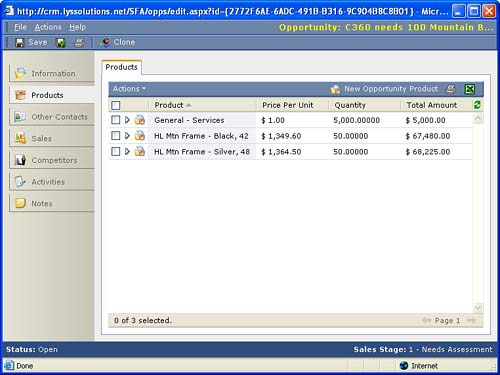
When we start looking at Quotes, Orders, and Invoices, we will see that these objects introduce the concept of Write In Products. Write In Products are products that are not in our master catalog, but can be added on-the-fly to fill a specific need. We are mentioning this here because there is no place to write in a product on the Products tab of the Sales Opportunity. Because the revenue that is used in all pipeline and forecast reports is based on the Products listed on the Opportunity, you might want to set up some sort of catchall product for items that you want to write to Sales Opportunities. For example, if your company occasionally provides some sort of service with the sales of a product, you could have a product generically called Service and give it a Price List cost of $1. This would allow you to include it on an Opportunity with a quantity that would bring the total to the desired amount for the engagement.
Other Contacts
The other contacts tab on the Opportunity record enables you to link any other Contacts in the database to the Opportunity record. This defines who outside your organization is involved in the Opportunity. Although this is a helpful feature, it would be even nicer to be able to define each Contact's role in the Opportunity.
Sales
The Sales tab on Opportunities is where Quotes, Orders, and Invoices are attached. Each Opportunity can have multiple Quotes, Orders, and Invoices and these can be created in succession starting from the Opportunity record itself. Figure 7.9 outlines the steps of a full Sales Opportunity life cycle. The reason we refer to this as a full life cycle is because there are a lot of different ways you can use Opportunities and their related objects.
Figure 7.9. The life cycle of a Sales Opportunity.
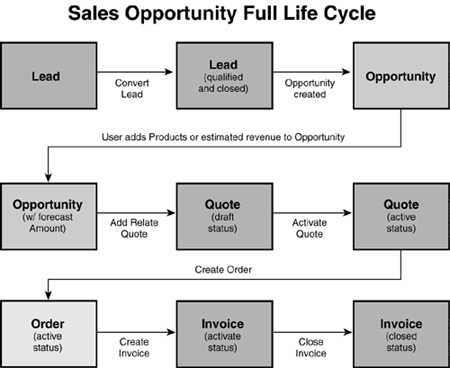
Quotes
A Quote is an offer to sell a mix of products or services for a specified amount of money. Quotes generally contain a list of the specific products and services offered as well as their prices and any discounts offered. Quotes can have an expiration date to indicate the term for which the offer will stay in effect. When you create a Quote from an Opportunity in Microsoft CRM, the list of Products on the Opportunity is automatically pulled onto the Quote. From there you can modify the product mix and even add Write In Products. As discussed earlier, Write In Products can be used to specify offered Products and Services that are not part of your organization's master Product list. In fact, you can create an entire Quote that consists solely of Write In Products. Figure 7.10 shows the Quote screen.
Figure 7.10. The Quote screen.
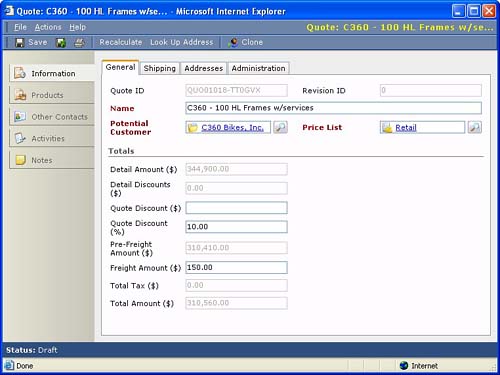
NOTELike a lot of Web-based CRM applications, Microsoft CRM uses Web pages to generate a printable Quote document from the Microsoft CRM Web interface. The benefits of this approach are that the CRM server can pull the appropriate fields from the Quote record, quickly merge them into an ASP page, and send the resulting HTML to the client for viewing and printing. The downside is that an administrator has to modify the ASP quote page to format the Quote. However, in the Microsoft CRM Outlook client, Quotes are created through merging the Quote data into a Microsoft Word template on the user's computer. This means that savvy end users will be able to customize their Quote templates to meet their individual or departmental formatting needs. |
Quotes in Microsoft CRM provide tremendous flexibility in terms of pricing and discounting. The total amount of any given Quote is equal to the sum of its Product line's items less any overall discounts. Each line item can be individually discounted, and the sum of all the individual discounts is totaled and displayed on the main Quote screen just before the Quote discount fields. The user can then see these cumulative discounts and add an overall discount to the Quote.
Figure 7.11 shows a Quote line item. Each Quote is made up of at least one line item. Each line item represents a distinct product that is being offered as part of the quote. Keep in mind that if you are including a Kit product on a Quote, the single Kit line item will represent multiple products.
Figure 7.11. A Quote line item.
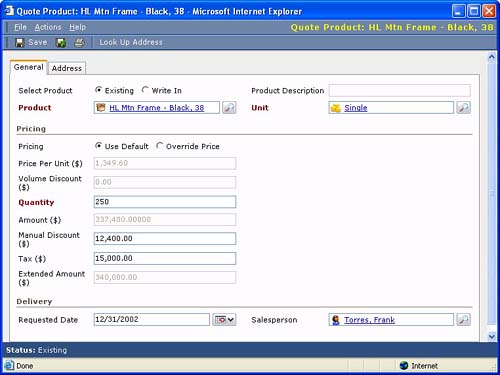
At the Quote line item level, a user can elect to use the default price from the Opportunity's default Price List, or the user can override the price altogether. The user can even enter different addresses for each Quote Product and specify whether to ship the item or have it held for pickup.
Orders
After a prospect or customer has accepted a Quote, an Order is typically placed. Microsoft CRM automates this process by allowing the user to create the Order from the Quote with one click of the Create Order button on the Quote screen. This is illustrated in Figure 7.12. Of course, an Order can be created without a Quote if the Quote process is skipped. When the user selects the Create Order button, he is presented with the option of updating the Opportunity to the closed status or not updating the Opportunity. The user can elect not to update the Opportunity in a situation where the active Order provides only a partial amount of the products and services on the Opportunity. Additionally, when the user is creating the Order, he can override the total price at that time and manually enter a total for the Order.
Figure 7.12. Creating an Order from a Quote.
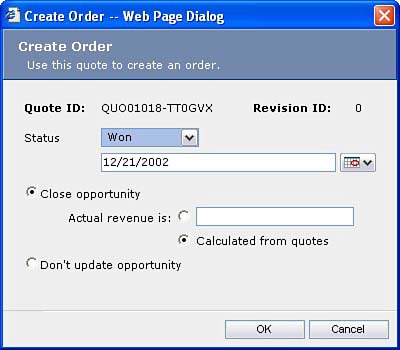
The Order screen, shown in Figure 7.13, is nearly identical to the Quote screen. The major difference is that the effective dates are not on the Order because it is assumed that it is in process and agreed upon billing terms will be in effect.
Figure 7.13. The Order screen.

After the Order has been created, an Invoice can be generated and delivered to the customer. Clicking the Create Invoice button on the Order screen generates the Invoice and opens the newly created Invoice's screen.
Invoice generation is an area where Workflow rules can be a big help. By configuring a Workflow rule to fire when Invoices are created, you can take a number of actions with respect to the Invoice. One simple action is to simply assign all Invoices to a user or Team in the Finance/Accounting department of your organization so that the Invoice can be entered into the billing system and delivered to the customer. This is a simple, yet effective, means of process integration. Of course if your organization is using the integration to Great Plains or another accounting system, this process will be automated. For information on configuring workflow, refer to Chapter 12, “Workflow.” For information on the Microsoft CRM to Great Plains integration, refer to Chapter 13, “Microsoft CRM Integration and Data Conversion.”
Invoices
The Invoice record is nearly identical to the Order record. The biggest difference is that a Close Invoice button replaces the Create Invoice button. Invoice records are used to create the bill that is sent to the customer. Order records are used to record the acceptance of the Quote and to trigger the creation of the Invoice. See Figure 7.14.
Figure 7.14. Closing an Invoice.
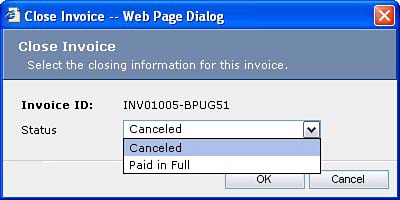
As with Quotes, Invoice records can be printed using Word merge by users of the Microsoft CRM Outlook client. Invoices can also be printed from the Microsoft CRM Web client, but customization of the format is more difficult and requires more of an administrative skillset.
